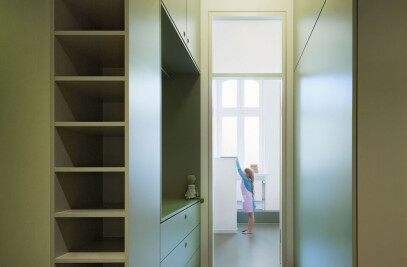Located on the edge of Kreuzberg, in the immediate vicinity of the Park am Gleisdreieck and Landwehrkanal, is the former headquarters of Ohrenstein und Koppel, or O&K for short. The mechanical engineering company was founded in 1876 by Benno Orenstein and Artur Koppel in Schlachtensee near Berlin.


Initially, the company produced light railway equipment and tipper trucks, later railways, construction machinery, escalators and ships. The network of production sites stretched across the whole of Europe and several other continents. In 1886, a plot of land was acquired on TempelhoferUfer, which was successively built on to house the headquarters of the rapidly growing industrial group. In 1913, O&K had a dozen factories and almost a hundred branches worldwide, employing nearly 15,000 people. The administrative building at Möckernstraße 120, which is now a listed building, dates from this period of economic prosperity. It was built in 1909-1910 according to the plans of the Berlin architectural firm Cremer & Wolffenstein.


In contrast to the classically structured façades - clad with tuff towards the street and glazed clinker in the courtyard - the internal structure consists of a then modern construction. Instead of a massive central wall, only two continuous iron columns support the ceilings of the front building. This created one large contiguous room per floor, which is still characteristic of the building's spatial structure today. The goal of the extensive renovation and conversion measures, which will be completed in 2022, was to preserve and leave visible both the original charm from the time of origin and the layers of time from the building's more than one hundred-year history that were added later. At the same time, a contemporary utilisation concept was developed for the building that combines flexibly divisible office and exhibition space.


The existing courtyard ceiling was demolished and the entire basement lowered by means of underpinning using the jet grouting method so that the newly created rooms have sufficient room height. Additional usable space was thus created on the property, which was originally already fully developed. A newly added extension in the courtyard, with its smooth façade of exposed concrete, contrasts with the historic wall surfaces of the existing building and zones the inner courtyard on two different levels, which are now connected to each other by a bright steel staircase.


The underground car park is accessed via a newly installed car lift, whose retractable gate has been inconspicuously integrated into the listed façade. In the rear part of the building, an additional escape staircase was built for fire protection reasons. A passenger lift was added to the existing historic staircase, which now makes the entire building handicapped accessible. Both the lift and the entrance doors to the individual floors were covered with heavy architectural bronze, a classic material that is intended to associate continuity and the continuation of the building's history and was also used in other parts of the building.


The staircase to the basement was also rebuilt, with a wrought-iron banister that was modelled on the historic structure. In addition to the entire building technology and all floors, windows and doors were also renewed, in part closely based on the historical model. Patina and traces of the past on wall and ceiling surfaces were deliberately preserved or carefully added.


Team:
Architect: Club Marginal Architekten
Photography: Waldemar Salesski


Material Used:
1. Facade cladding: Tuff Stone, glazed clinker, Light Concrete
2. Flooring: Exposed Screed
3. Doors: HOBA fire protection door
4. Windows: Custom made
5. Roofing: Rheinzink
6. Electrical switches: Berker Serie 1930
7. Fittings: Hansgrohe AXOR Citterio
8. Car lift: Serapid Rigid Chain Technology






















































